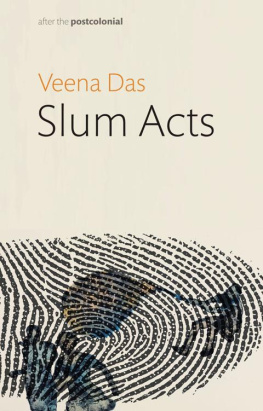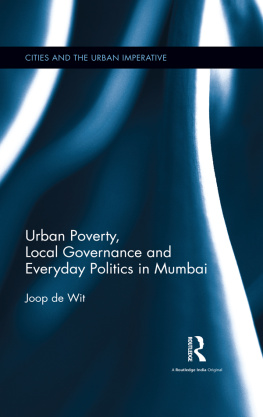Dharavi
From Mega-Slum to Urban Paradigm
Cities and the Urban Imperative
Series Editor: Sujata Patel, Professor, Department of Sociology, University of Hyderabad
This series introduces a holistic approach to studying cities, the urban experience, and its imaginations. It assesses what is distinctive of the urban phenomenon in India, as also delineates the characteristic uniqueness of particular cities as they embrace change and create ways of experiencing modernities.
Taking an interdisciplinary route, the series evaluates the many facets of urbanisation and city formation, and explores the challenges faced in relation to regional, national and global processes.
The books in this series present the changing trends in macro and micro urban processes; the nature of demographic patterns of migration and natural growth therein; spatial reorganisation and segregation in urban areas; uneven economic development of manufacturing and services in cities; unequal access to power in the context of formal citizenship; increasing everyday violence and declining organised protest; breakdown of urban family life in juxtaposition with the reconstitution of community. They trace how new forms of socialities are replacing old forms of trust and solidarity, and how these are being institutionalised in distinct and diverse ways within South Asia.
Also in this Series
Growing up in the Knowledge Society: Living the IT Dream in Bangalore
Nicholas Nisbett
ISBN 978-0-415-55146-5
Governing Indias Metropolises: Case Studies of Four Cities
Editors: Jol Ruet and Stephanie Tawa Lama-Rewal
ISBN 978-0-415-55148-9
Indias Middle Class: New Forms of Urban Leisure, Consumption and Prosperity
Christiane Brosius
ISBN 978-0-415-54453-5
Urban Navigations: Politics, Space and the City in South Asia
Editors: Jonathan Shapiro Anjaria and Colin McFarlane
ISBN 978-0-415-61760-4
Participolis: Consent and Contention in Neoliberal Urban India
Editors: Karen Coelho, Lalitha Kamath and M. Vijayabaskar
ISBN 978-0-415-81193-4
First published 2013 in India
by Routledge
912 Tolstoy House, 1517 Tolstoy Marg, Connaught Place, New Delhi 110 001
Simultaneously published in the UK
by Routledge
2 Park Square, Milton Park, Abingdon, OX14 4RN
Routledge is an imprint of the Taylor & Francis Group, an informa business
2013 Marie-Caroline Saglio-Yatzimirsky
Typeset by
Eleven Arts
Keshav Puram
Delhi 110 035
All rights reserved. No part of this book may be reproduced or utilised in any form or by any electronic, mechanical or other means, now known or hereafter invented, including photocopying and recording, or in any information storage and retrieval system without permission in writing from the publishers.
British Library Cataloguing-in-Publication Data
A catalogue record of this book is available from the British Library
ISBN 978-0-415-81252-8
Between pages 230 and 231
Dharavis spaces
Dharavi workers
Dharavi workers: Charmakars
Politics in Dharavi
Dharavi rehabilitation planning
All photographs courtesy of E. Boissinot, August 2010.
Marathi and Hindi terms have been italicised in the text. They have been transcribed according to the usual rules and have not been conjugated. Caste names have been written with the first letter in capitals (example: Chambhars, Dhors), but not when used as adjectives (example: dhor practices).
The original names of places have been retained. The names of persons have been changed, except in cases where we had the agreement of those concerned. The original names of political personalities, particularly in , have been retained.
WHY come back to the subject of Dharavi again, undoubtedly the most widely known Asian slum in the world, 20 years after initiating research leading to an anthropological study of its communities? One may wonder whether the research scholar failed to separate herself from her primary subject. Owing to its human organisation, Dharavi reveals an urban form that is both unique and a future archetype of the gigantic, poor and illegal concentrations that are mushrooming in the multi-millionaire megapolises of the South. Its profoundly unequal multi-ethnic space, marked both by traditional hierarchies and new ways of marginalisation, is intensely dynamic and creative, much more than it was 10 years ago, offering alternative forms of solidarity, mobilisation and governance. I am therefore trying to pay a final tribute to Dharavithe fruit of 20 years of work and intense curiosity. And yet, this study is meant to be even more humble than the preceding workso by what strange epistemological mechanism has the subject of knowledge become even more complex as we went along? Today, I am saying my goodbyes to the inhabitants I met in Dharavi with the same admiration I had earlier, which has been incessantly reinforced with each field visit. In Dharavi, you will not find exhausted people languishing under the hardships of life, misery and exclusiona sight that is quite commonplace both on pavements in countries of the South and also, perhaps for other reasons, in the countries of the North. You will see faces worne by suffering and hardshipbut they do not give up. It is to all of themfor the lessons of strength and dignity they gave methat I dedicate these lines on their living environment.
LIKE the first, this second study on Dharavi has been an adventure alongside the hundreds of witnesses from far and wide in my field surveys, friends and colleagues. I would first and foremost particularly like to thank Shariva Naik, Nilesh Kulkarni and the Malegaonkars for their kindness in facilitating meetings and fieldwork; Frdric Landy, Nicolas Bauts and Vronique Dupont from the Social Exclusion, Territories and Urban Policies (SETUP) programme; and my colleagues from So Paulo University for the quality of their discussions. For brief but intense hours that were given to me in the overwhelming world of Mumbai: Prasad Shetty, Anirudh Paul, Sunder Burra, and Kalpana Sharma. And also, Sujata Patel, who welcomed the idea of bringing out this book. Not to forget Elonore Boissinot, for her photographic talents, and Jessica Hackett for her kind and professional proofreading.
Social Exclusion, Territories and Urban Policies: A Comparison between India and Brazil (SETUP) was an international project which ran from November 2006 to May 2010, coordinated by M.-C. Saglio-Yatzimirsky and F. Landy and funded by the French National Research Agency. It aimed to understand the social and territorial dynamics occurring in slums in the four megalopolises of Mumbai, Delhi, So Paulo, and Rio de Janeiro. See http://setup.csh-delhi.com (accessed 14 September 2011).
Both the Institut National des Langues et Civilisations Orientales (INALCO, Paris) where I have tenure as professor of Indian Studies and the Centre dtudes de lInde et de lAsie du Sud (CEIAS, Paris) have been of great help in scientifically facilitating this study. Last but not least, the Institut Universitaire de France (IUF) which is supporting my project research on the morphology of slums in southern countries (200914), and gave me the time and the fundings to go through with this project.






